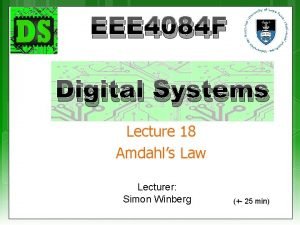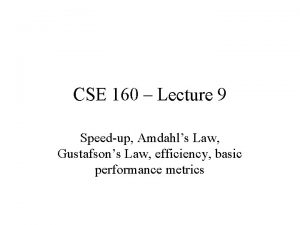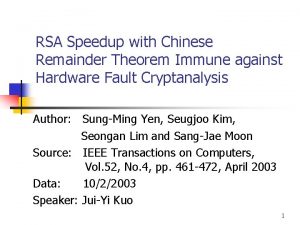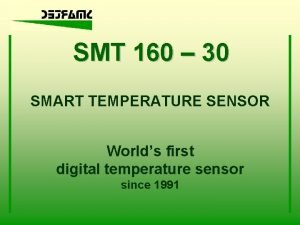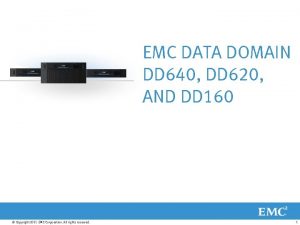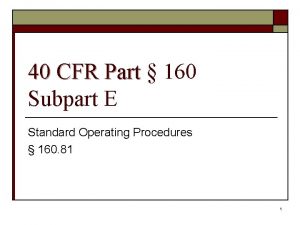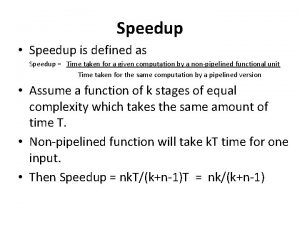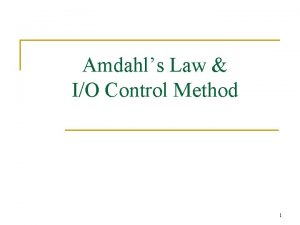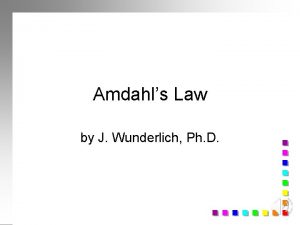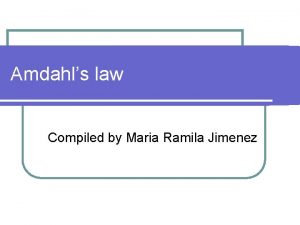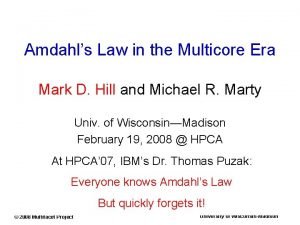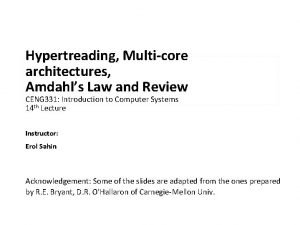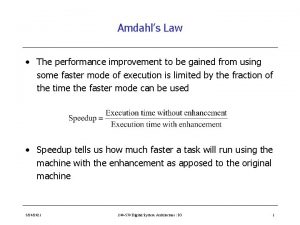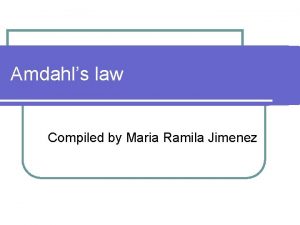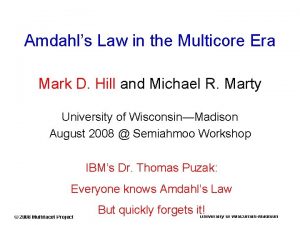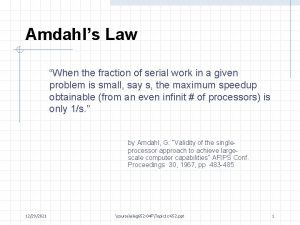CSE 160 Lecture 9 Speedup Amdahls Law Gustafsons
























- Slides: 24

CSE 160 – Lecture 9 Speed-up, Amdahl’s Law, Gustafson’s Law, efficiency, basic performance metrics

Exam 1 • 9 May 2000, 1 week from today • Covers material through HW#2 + through Amdahl’s law/Efficiency in this lecture • Closed book, Closed Notes. You may use a calculator. • At the end of this lecture –will ask you for a list of things you want reviewed during next lecture.

Concurrency/Granularity • One key to efficient parallel programming is concurrency. • For parallel tasks we talk about the granularity – size of the computation between synchronization points – Coarse – heavyweight processes + IPC (interprocess communication (PVM, MPI, … ) – Fine – Instruction level (eg. SIMD) – Medium – Threads + [message passing + shared memory synch]

One measurement of granularity • Computation to Communication Ratio – (Computation time)/(Communication time) – Increasing this ratio is often a key to good efficiency – How does this measure granularity? • CCR = ? Grain

Communication Overhead • Another important metric is communication overhead – time (measured in instructions) a zerobyte message consumes in a process – Measure time spent on communication that cannot be spent on computation • Overlapped Messages – portion of message lifetime that can occur concurrently with computation – time bits are on wire – time bits are in the switch or NIC

Many little things add up … • Lots of little things add up that add overhead to a parallel program – Efficient implementations demand • Overlapping (aka hiding) the overheads as much as possible • Keeping non-overlapping overheads as small as possible

Speed-Up • S(n) = – (Execution time on Single CPU)/(Execution on N parallel processors) – ts /tp – Serial time is for best serial algorithm • This may be a different algorithm than a parallel version – Divide-and-conquer Quicksort O(Nlog. N) vs. Mergesort

Linear and Superlinear Speedup • Linear speedup = N, for N processors – Parallel program is perfectly scalable – Rarely achieved in practice • Superlinear Speedup – S(N) > N for N processors • Theoretically not possible • How is this achievable on real machines? – Think about physical resources of N processors

Space-Time Diagrams • Shows comm. patterns/dependencies • XPVM has a nice view. Process Time 1 2 3 Overhead Waiting Computing Message

What is the Maximum Speedup? • f = fraction of computation (algorithm) that is serial and cannot be parallelized – Data setup – Reading/writing to a single disk file • ts = fts + (1 -f) ts = serial portion + parallelizable portion • tp = fts + ((1 -f) ts)/n • S(n) = ts/(fts + ((1 -f) ts)/n) = n/(1 + (n-1)f) <- Amdahl’s Law Limit as n -> = 1/f

Example of Amdahl’s Law • Suppose that a calculation has a 4% serial portion, what is the limit of speedup on 16 processors? – 16/(1 + (16 – 1)*. 04) = 10 – What is the maximum speedup? • 1/0. 04 = 25

More to think about … • Amdahl’s law works on a fixed problem size – This is reasonable if your only goal is to solve a problem faster. – What if you also want to solve a larger problem? • Gustafson’s Law (Scaled Speedup)

Gustafson’s Law • Fix execution of on a single processor as – s + p = serial part + parallelizable part = 1 • S(n) = (s +p)/(s + p/n) = 1/(s + (1 – s)/n) = Amdahl’s law • Now let, 1 = s + = execution time on a parallel computer, with = parallel part. – Ss(n) = (s + n)/(s + ) = n + (1 -n)s

More on Gustafson’s Law • Derived by fixing the parallel execution time (Amdahl fixed the problem size -> fixed serial execution time) – For many practical situations, Gustafson’s law makes more sense • Have a bigger computer, solve a bigger problem. • Amdahl’s law turns out to be too conservative for high-performance computing.

Efficiency • E(n) = S(n)/n * 100% • A program with linear speedup is 100% efficient.

Example questions • Given a (scaled) speed up of 20 on 32 processors, what is the serial fraction from Amdahl’s law? , From Gustafson’s Law? • A program attains 89% efficiency with a serial fraction of 2%. Approximately how many processors are being used according to Amdahl’s law?

Evaluation of Parallel Programs • Basic metrics – Bandwith – Latency • Parallel metrics – Barrier speed – Broadcast/Multicast – Reductions (eg. Global sum, average, …) – Scatter speed

Bandwidth • Various methods of measuring bandwidth – Ping-pong • Measure multiple roundtrips of message length L • BW = 2*L*<#trials>/t – Send + ACK • Send #trials messages of length L, wait for single ACKnowledgement • BW = L*<#trials>/t • Is there a difference in what you are measuring? • Simple model: tcomm = tstartup + ntdata

Ping-Pong • All the overhead (including startup) are included in every message • When message is very long, you get an accurate indication of bandwidth Time 1 2

Send + Ack • Overheads of messages are masked • Has the effect of decoupling startup latency from bandwidth (concurrency) • More accurate with a large # of trials Time 1 2

In the limit … • As messages get larger, both methods converge to the same number • How does one measure latency? – Ping-pong over multiple trials – Latency = 2*<#ntrials>/t • What things aren’t being measured (or are being smeared by these two methods)? – Will talk about cost models and the start of Log. P analysis next time.

How you measure performance • It is important to understand exactly what you are measuring and how you are measuring it.

Exam … • What topics/questions do you want reviewed? • Are there specific questions on the homework/programming assignment that need talking about?

Questions • Go over programming assignment #1 • Go over programming assignment #2
 Amdahl's law calculator
Amdahl's law calculator Gustafson's law in computer architecture
Gustafson's law in computer architecture Chinese remainder theorem rsa
Chinese remainder theorem rsa Yix speedup
Yix speedup 01:640:244 lecture notes - lecture 15: plat, idah, farad
01:640:244 lecture notes - lecture 15: plat, idah, farad Newton's first law and second law and third law
Newton's first law and second law and third law Newton's first law and second law and third law
Newton's first law and second law and third law Boyles law
Boyles law Boyle's law charles law avogadro's law
Boyle's law charles law avogadro's law 60 sayısının 150 si kaçtır
60 sayısının 150 si kaçtır Smt160-30
Smt160-30 Dbhds incident reporting
Dbhds incident reporting Wac 296-800-160
Wac 296-800-160 Anticorps anti-nucléaire positif moucheté
Anticorps anti-nucléaire positif moucheté Konica minolta bizhub 160
Konica minolta bizhub 160 Parafrasi il canto delle sirene dal verso 160
Parafrasi il canto delle sirene dal verso 160 Data domain 160
Data domain 160 40 cfr part 160
40 cfr part 160 Carolina windom 160
Carolina windom 160 160 5th ave nyc
160 5th ave nyc What does similar triangles mean
What does similar triangles mean Un tercio cuanto es
Un tercio cuanto es 6280/160
6280/160 Capr 160-1
Capr 160-1 Bentuk penjumlahan dari 2 cos 100°.cos 35° adalah…
Bentuk penjumlahan dari 2 cos 100°.cos 35° adalah…
